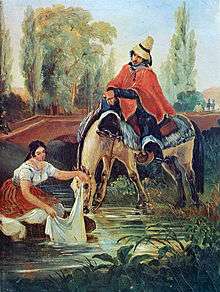Washerwoman
| Look up washerwoman in Wiktionary, the free dictionary. |


A washerwoman or laundress is a woman who takes in laundry. Both terms are now old-fashioned.
Description
As evidenced by the character of Nausicaa in the Odyssey, in the social conventions depicted by Homer and evidently taken for granted in Greek society of the time, there was nothing unusual or demeaning in a princess and her handmaidens personally washing laundry. However, in later times this was mostly considered as the work of women of low social status. The Magdalene asylums chose laundering as a suitable occupation for the "fallen women" they accommodated. In between these two extremes, the various sub-divisions of laundry workers in C19th France (blanchisseuse, lavandière, laveuse, buandière, repasseuse, etc.) were respected for their trade. A festival in their honour was held at the end of winter (Mi-Careme, halfway through Lent, i.e. three weeks after Mardi Gras or Shrove Tuesday).[1] This festival has now been revived as Mi-Carême au Carnaval de Paris.
While having a significant social function in various human cultures over thousands of years, the spread of washing machines and self-service laundries has rendered washerwomen unnecessary in much of the contemporary world.
Popular culture
There are copious examples of washerwomen or laundresses in art (see WikiCommons) and some examples in literature as well:
- the disguise adopted by Toad, one of the protagonists of Wind in the Willows, in order to escape from prison.
- In A Christmas Carol, an unnamed laundress worked for Ebenezer Scrooge. When the Ghost of Christmas Yet to Come showed him his future where he is dead, the laundress assists the charwoman Mrs. Dilber and the unnamed undertaker into stealing some of Scrooge's belongings and selling them to a fence named Old Joe.
- In The Penultimate Peril story of the Lemony Snicket book series A Series of Unfortunate Events, Count Olaf's minion Kevin poses as a washerwoman who works in the laundry room at the Hotel Denouement.
See also
- Dhobi, the washermen of India
- Baths and wash houses in Britain
- Blanchisseuse, a village named after its washerwomen
- Les Lavandières, a group of three old women in Celtic folklore
References
- ↑ Monjaret, Anne (1995). "La Fete de la Sainte-Catherine a Paris dans les Annees Folles". Ethnologia Europaea: Journal of European Ethnology. 25 (1): 150.